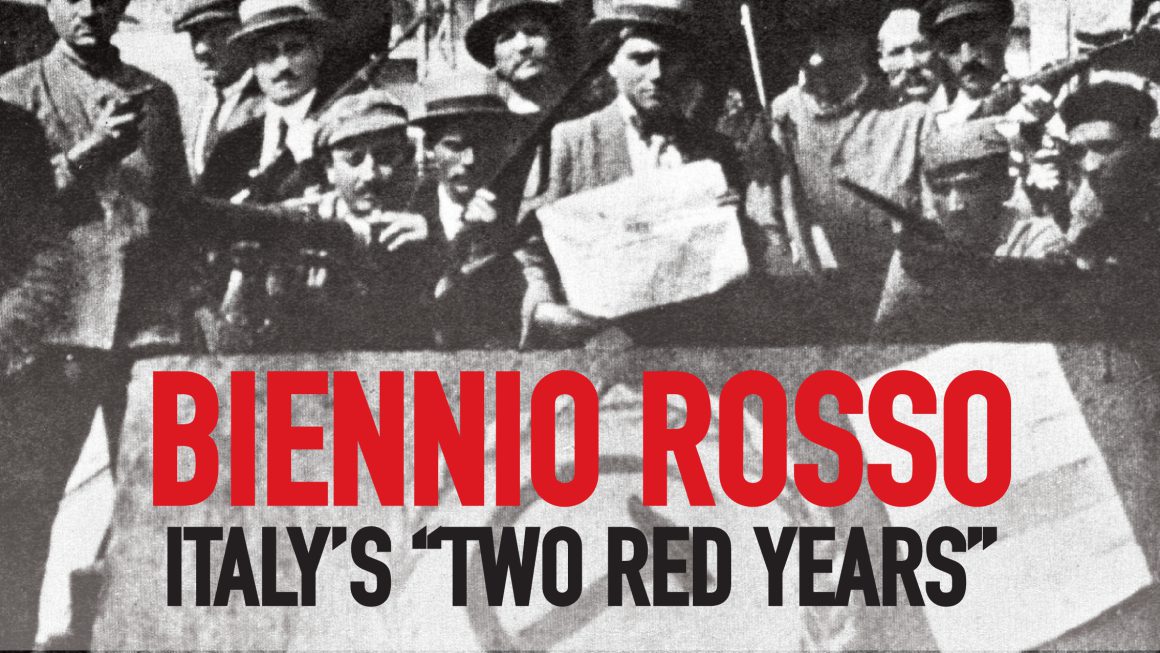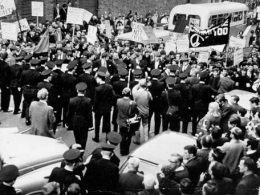By Massimo Amadori and Giuliano Brunetto (Resistenze Internazionali — ISA in Italy)
One hundred years ago, Italy was shaken by the “Two Red Years”, a revolutionary period in which armed workers took over the factories. Although much has been written to mark the anniversary of the end of the First World War, or even the 150th anniversary of Italian Unification, Biennio Rosso has been practically ignored, even by Italy’s trade unions such as the CGIL and FIOM, which then played a key role in those events.
Celebrations, which anniversaries to mark or not mark, are never a politically neutral choice. Each historical epoch reconstructs its past, its memory, revisiting it in a more or less unconscious way to explain or justify the present. This is also happening today.
This explains why, in the historical context of Italy today, when the ruling elite is encouraging the growth of nationalism disguised as “sovereignty”, and the traditional organizations of the workers’ movement have been dramatically weakened, the hundredth anniversary of the Biennio Rosso is an annoying reminder of the past, to be evoked in passing, or rather not at all.
For the same reason, while they are attempting to erase the memory of the red years from schools, universities and public debate, they are rewriting the past, brushing over the crimes of fascism.
For about the last twenty years, at least in Italy, history is being revised with the aim of attacking the Resistance, by equating the anti-fascist partisans to the fighters of the Italian Social Republic (RSI), the German puppet state led by Mussolini. In the writings of those such as by Giampaolo Pansa, the historical and moral responsibilities of the fascists are hidden behind “their presumed idealism and their young age”. There are many publications that ignore, or hide the crimes of Italian colonialism, its racial laws, the invasion of Ethiopia, Albania, France, Greece, Yugoslavia and the Soviet Union by Fascist Italy, or the war crimes committed by the Royal Italian Army in Ethiopia, starting with the use of gas against civilians, as well as the responsibility of the fascist regime for the deportation of Italian Jews and those who lived in the territories militarily subjugated to the Axis.
Origins of the Biennio Rosso
Just as with the Russian Revolution of 1917, the Hungarian Revolution of 1919 or the German Revolution of 1918–1919, it is the political and social consequences of the First World War that laid the ground for the Italian Red Two Years.
The horrible carnage led to the death of 651,000 soldiers and, from hunger and disease, 589,000 civilians. In total, this equalled 3.5% of the Italian population. This huge figure equals the number of losses recorded, for example, by the formally defeated Alliance powers of Germany and Austria-Hungary.
Even this horrific figure does not fully account for the tragedy that the great war represented for the popular masses, especially for the peasants and workers of the poorest regions of the country. The war spread over the predominantly agricultural country, which was ruled by an obtuse, reactionary and unpopular monarchy, that had only just been become an all-Italian autocracy following the unification of the nation just fifty years earlier.
Although officially part of the Alliance of Germany, Austria-Hungary and the Ottoman Empire, Italy only entered the war on the side of the Entente, France, Russia and England following the “London Pact” in May 1915. The agreement guaranteed that Italian imperialism would get its share of the spoils once the war was over. The “Italian spoils” were mainly to be found in the region of Istria and Dalmatia, the disputed lands of present-day Slovenia occupied at the time by the Habsburg Empire.
The “Radiant Days of May”
Italy differed from Germany and France, where in 1914, the forces of Social Democracy had turned their backs on the principle of working-class Internationalism and sided with their respective national bourgeoisies in that, albeit critically, the Italian Socialist Party (PSI) defended a position of neutrality and condemned the ongoing massacre from the very beginning of the hostilities.
Within the PSI, however, a nationalist and interventionist tendency crystallized, which at first defended “active neutrality” against “Germanic militarism” and then “interventionism”. This tendency was led by the former director of “Avanti”, the PSI newspaper, Benito Mussolini.
Having broken with socialism, Mussolini and other ex-supporters of the PSI such as the former trade unionist and deputy Alceste De Ambris, joined forces with those of the nationalists led by the popular poet Gabriele d’Annunzio and began to campaign forcibly for Italy to enter the war. To this end they launched the new daily newspaper “Il Popolo d’Italia” edited by Mussolini which dramatically increased interventionist propaganda. “Il Popolo d’Italia” was financed first by other bourgeois newspapers such as “Corriere della Sera” and “Resto del Carlino”, then by important industrialists, among them the Perrone brothers, owners of the Ansaldo di Genova, which produced 46% of the artillery used by Italy during the war, and finally by the secret services of France and Great Britain.
A key moment in the development of the interventionist campaign was the foundation of the Revolutionary Action League (del Fascio), founded as early as 1914 by Mussolini and De Ambris with the precise aim of accelerating preparations for entry into the war. The Fascio’s program was published on January 1, 1915 in “Il Popolo d’Italia” and in a few months the Fasci managed to organize 9000 members. From the Revolutionary Action League the Italian Combat Leagues were set up in 1919, then in 1921 became the National Fascist Party.
Despite the wishes of the industrialists, the monarchy and the army who wanted to enter the war, it was still necessary to convince the proletariat, a large majority of whom were hostile to, or at least not very convinced of, the intervention. In May 1915, what became known in history as the “radiant days of May” saw open confrontations in city squares across Italy which left many dead and wounded. On the one side workers and the working classes, mainly socialists who were for neutrality, on the other sons of the wealthy, the renegade socialists, nationalists and futurist intellectuals who wanted war for the most disparate reasons, some out of boredom or for nationalist reasons, others because they had material interests at stake.
It was the warmongers and steel industrialists who ended up ‘radiant’ as by the end of the month they had prevailed against the anti-war movement.
While the monarchy and the army high command were delighted with their plans of conquest, millions of men, commanded by mainly Piedmontese officers, who often did not speak and did not understand the dialects spoken by the peasant soldiers, were forced to fight a war they did not want and did not understand.
Badly trained and badly equipped, they were used as real cannon fodder by the aristocratic commanders who imposed “Avanti Savoia” (Forward Savoy — the royal house of Italy at that time) as a battle cry and forced millions of men to launch pointless assaults on the Austro-Hungarian positions, usually defended by Serbs, Croats, Slovenes and Romanians, during the twelve battles of the Isonzo fought between June 1915 and November 1917.
Post-war division
Formally a victor in the war, Italy in 1918 was a dramatically divided country. Those who had fought in the trenches remembered the harassment suffered at the hand of the officers, the shootings by the hated Carabinieri and the exemplary punishments. They remembered the fate of the many who had been killed in retaliation or to maintain “rigor and order” in the trenches. They remembered the fate of the young gunner Alessandro Ruffini who was clubbed and then shot by General Graziani because, during an inspection he had not removed his cigar from his mouth. After the war, after the nationalist exaltations and the fear of invasion, millions of men returned to their homes, their fields and their factories, bringing with them the feelings of hatred and brutality that the high commands had so skilfully evoked.
Post-war Italy was still strongly agrarian, the country had to face the collapse of agricultural production due to the reduction in the number of peasants who had perished at the front and the continued existence of large landed estates. Compared to 1914, when wheat production was 52 million hundredweight, in 1920 Italy produced barely 28 million hundredweight.
As if that wasn’t enough, inflation had reached very high levels and wages had stood still, making life impossible for millions of Italians. In 1918 wages represented only 64.6% of the 1913 quota. At the same time, the big capitalists and those industrial groups like Ansaldo, Breda or Fiat that had enriched themselves beyond all limits with profits from military orders, continued to dictate the political agenda of the government.
At the end of the war, discontent grew within the whole working class, which returned to work in very difficult conditions and with starvation wages, and within the peasant class to which the land had been promised during the war, but which returned to work under the same conditions as before as sharecroppers or labourers.
Explosive situation developing
Into this mix of general discontent was thrown a layer of the veterans, simple soldiers but above all the NCOs and officers, who were unable to reintegrate into civilian life and looked with terror mixed with hatred at those peasants and socialist workers who had been against the war during the imperialist carnage and with whom they had clashed during the “radiant days of May”.
The conflict between socialist and anarchist workers and the ex-combatants and former interventionists broke out into violent clashes in Milan on 15 April 1919. On that occasion, activists of the early futurist movements and first wave of fascists acted together and assaulted the headquarters of the PSI newspaper: the Avanti!
This created an explosive situation. A vast and militant mass movement which began in the spring of 1919 lasted until September 1920 only after several of the large factories in Northern Italy had been occupied.
Strikes and occupations
Biennio Rosso was a period of very radical actions, with numerous strikes and military actions and which, although concentrated mainly in northern and central Italy, involved the whole Italian peninsula, from Piedmont in the west to Sicily in the south. Workers and labourers demanded higher wages and better working conditions. To the purely economic demands were soon added the general political demands. When the news came from Russia that with the Revolution the peasants had obtained the land, they began to demand the take-over of the land too.
Biennio Rosso was the birth in Italy of a revolutionary movement directly inspired by the Russian Revolution of October 1917. “Doing as in Russia” became the watchword of the most advanced section of the Italian workers’ movement.
In reality, already in 1917, there had been semi-insurrectional episodes organized in the north and south of the country in solidarity with the Bolshevik revolution. They had led to temporary occupations of the land, which intensified and were generalized two years later. Although mainly in the northern provinces of Emilia Romagna, Veneto and Lazio, there were also important struggles involving organised veterans for the occupation of uncultivated land in the southern regions of Puglia, Calabria and Sicily.
In Turin the workers occupied the FIAT factories, the pride and joy of Italian capitalism. In the occupied factories, factory councils were formed, democratically elected by the workers themselves modelled on the Russian Soviets. The workers asked to control production. In the occupied factories, armed detachments of workers were formed, the so-called Red Guards, who defended the occupations from the army and the fascist squads, and were preparing themselves for the insurrection. The Marxist Antonio Gramsci played a leading role in the movement of the workers’ councils in Turin and appealed repeatedly in the newspaper “Ordine Nuovo” for this network of works councils that were becoming embryonic elements of double power to be extended.
Contradictions within the PSI
On the political side, the workers and peasants were represented by the PSI, within which a right wing and a revolutionary wing co-existed. The PSI had been pushed, immediately after the war, to the left. This significant shift in the political centre of gravity of the PSI was determined, on the one hand, by the victory of the Russian Revolution and, on the other, by the growing strength of the socialist rank and file which, radicalized by the post-war conditions, was looking for solutions to break with capitalism.
This radicalisation resulted in a spectacular growth of the PSI from 24,000 members in 1918 to over 200,000 in 1920. At the same time the trade unions grew: the Italian General Conferation of Labour (CGIL) could count on almost two million members, while the anarchists of the Italian Syndicalist Union organized no less than 800,000 workers.
During its XVI congress held in Bologna between October 5 and 8, 1919, the PSI approved by a majority the proposals of the Party’s radical wing, led by Giacinto Serrati, who wanted the PSI to join the III International. The moderates of Filippo Turati were resoundingly defeated.
Joining the Third International, Gramsci explained, had taken place without a real political understanding of the implications. The leadership of the party remained dominated by a tendency to make political concessions in order to maintain the unity of the party with the reformists.
Within the PSI, an openly communist wing also developed in 1919, which pushed to expel Turati’s reformists from the party, following Lenin’s recommendations. These included the Revolutionary Marxist tendency of the PSI grouped around Antonio Gramsci, who launched his newspaper “L’Ordine Nuovo” in Turin in 1919 and who played a critical role in the occupation of the factories. He was joined, in southern Italy, by Amedeo Bordiga who led the revolutionary wing of the party, grouped around the weekly “Il Soviet”. Serrati’s “centrists” shared the revolutionary positions of Gramsci and Bordiga but, not wanting to expel the reformists from the Party, they remained hostages of Turati and were unable to elaborate a revolutionary strategy.
In the elections of November 1919, the PSI ended up in first place, obtaining 32.4% of the votes. The electoral success of the Socialists was directly linked to the radicalization of the workers’ and farmers’ movement during the Biennio Rosso. In 1919 alone there were more than 1800 strikes, involving more than 1.5 million strikers.
Open class conflict
In 1920, there were more than 2000 strikes involving about two and a half million people. The revolutionary movement culminated in September 1920, with the majority of the metallurgical factories in northern Italy occupied by workers. The occupation involved about half a million people. In response, the General Confederation of Agriculture, uniting agriculturalists and landowners, and Confindustria, the union of then 11,000 industrialists developed national structures and organizations in 1920.
In June 1920, sharpshooter soldiers of the Bersaglieri regiment launched a revolt in Ancora. Their action was preceded by the rebellion of a group of assault troops who mutinied against their officers as they were about to embark for Albania, which was under Italian military occupation. From Ancona the revolt spread to the Marches, Umbria and then Rome. Railway workers went on strike to prevent the Royal Army from intervening, but the revolt was eventually quelled by the Navy, which intervened to bomb the city.
The climax of the Biennio Rosso was reached when on 29th March 1920, when 1.2 million workers started a strike involving all the metallurgical workshops in Turin. The industrialists responded with a lock-out and demanded the dissolution of the works councils. Nevertheless, by September, all the metallurgical companies in the north of the country had been occupied, involving over half a million workers. In those factories, production continued managed by the workers committees, who also controlled supplies and maintained contacts with other factories involved in the struggle. In the following month, the strike was extended and generalized to the chemical, press and construction sectors and extended across the borders of Piedmont with solidarity strikes organized by the working class in Florence, Livorno, Bologna and Genoa.
To respond to the threat of Revolution and to put an end to the occupation movement, Prime Minister Giolitti sent 50,000 soldiers to Turin. Isolated, without leaders, without weapons and under threat, the workers of Turin surrendered and left the factories they had occupied.
On 19th September 1920 the CGIL approved an agreement with Confindustria. This agreement provided for wage increases and other improvements in the condition of the workers, but also provided for the factories occupied by the workers to be evacuated. The PSI and union leaders eventually capitulated and the revolutionary movement was defeated. From this defeat the Italian workers’ movement never recovered: at this point it was the bosses who took the initiative, financing the reactionary forces, the National Fascist Party primarily to defeat the working class which had just provided an extraordinary example of self-management and revolutionary discipline.
Failure of leadership
One of the reasons for the defeat of the workers movement was the inability of the political and union leadership of the movement to extend and strengthen it. Dominated as it was by the internal conflict between its revolutionary and reformist wings, the PSI was incapable of putting forward credible and concrete political proposals.
In words, in its newspapers, in speeches, in parliament, it defended a revolutionary perspective, but in reality it implemented a policy that aimed at obtaining reforms for the working class. In reality, it was more concerned that the development of a radical revolutionary movement would risk its position and its place at the negotiating table with the government and the industrialists.
The PSI applied a centrist policy in the sense that its revolutionary phraseology was accompanied by a reformist policy of class collaboration. Its use of revolutionary phraseology initially generated enthusiasm, but then great frustration among the masses. The PSI proved incapable of playing a leading role and of orienting itself, for example, towards those sectors of war-veterans, who had become radicalised over the question of land and wages in the previous period. In addition, Serrati’s party failed to find a dialogue with the peasant masses of Southern Italy, who were left without political direction, without ties and without contact with the revolutionary movement of the factories of the North.
For its part, the CGIL did not move to generalize the strikes, or to strengthen the active solidarity with the strikers that was developing in many Italian regions.
Bourgeois use the fascists
During these insurrectionary months, the Italian bourgeoisie was seriously afraid it would be thrown out of power. If this did not happen, it was only because of the unpreparedness and surrender of the leaders of the working class. In the local elections of 1920, the PSI was relatively successful. It won, among other things, the majority of the municipal administrations in Emilia-Romagna and Tuscany. In those regions, landowners and employers began to mobilize the forces of reaction and the young downtrodden and declassed elements in search of “action”, who were moving towards the Fascist Party.
Beginning in 1920, the fascist squads, supported by landowners and industrialists, attacked the headquarters of the trade unions and left-wing parties, as well as assaulting and murdering striking workers and labourers, trade unionists, and the socialist and communist militants.
The landlords provided funds and resources, among them, the trucks with which the fascist squads were driven into the socialist communes for lightning assaults on people’s houses and the peasant leagues. Often these raids ended with the brutal murders of socialist leaders, and this had the effect of terrorizing the peasants and ordinary workers.
For their part, the forces of the liberal bourgeoisie worked to build, in these same elections, “national blocs” of all the forces hostile to socialism. Legitimizing the National Fascist Party in this way, they prepared the conditions, including the support of the monarchy and the majority popular party, for the “march on Rome”, the coup d’état of 28th October 1922.
The Fascists had the financial support of big capital, but their social base continued to be overwhelmingly the middle class, and those elements of the petit-bourgeoisie that had been impoverished by the economic crisis, and disappointed by the results of the Biennio Rosso.
In January 1921, the Communist Party of Italy (PCI) was finally born, after the revolutionary wing of the PSI, led by Gramsci and Bordiga split away. The PCI, the Italian section of the Communist International appeared when the powerful wave of the class movement had already run aground, when the Italian workers’ movement had been greatly weakened and fascism was preparing to take power.
Workers fight the fascists
Despite the burning defeat of the Italian workers’ movement, the fascists still met strong resistance from the left militants, who often opposed their violent attacks with arms in hand during the ‘two black years’. Initially, the response of the anti-fascists was disorganized and insufficient, but in the summer of 1921, the anarchist Argo Secondari, who had been a soldier during the First World War, founded the ‘Arditi del Popolo’, armed squads composed primarily of workers and ex-soldiers, who had the task of defending the workers’ movement from the fascist squads. It was a real united front of the forces of the left which sprung up spontaneously and consisting mainly of socialist militants, communists and anarchists.
The Parma socialist revolutionary Guido Picelli, who years later fought with the republicans in the Spanish war joined Secondari as a leader of this anti-fascist movement. Lenin, in the pages of Pravda, wote enthusiastically about the establishment of the ‘Arditi del Popolo’, which managed to hold the fascist squads at bay at least until the march on Rome. Every time the Fascists attacked a union headquarters, a cooperative, someone’s home, a workers’ strike and so on the ‘Arditi del Popolo’ defended their comrades with weapons in their hands. There were deaths on both sides. It was not uncommon for the fascists to be forced to flee.
At the end of July, unions and left-wing parties called a strike throughout Italy against the fascists and against state and police complicity with their violent actions. The strike was particularly well supported and effective in Parma. As the government was reluctant to repress the strike, the fascists organized instead. About 10,000 fascist squads under Italo Balbo’s command made their way to Parma to teach the workers who had dared to strike a lesson. The ‘Arditi del Popolo’, led by the legendary Guido Picelli, masterfully organized the defense of the city and, for a few days, forced the fascists to retreat. They suffered heavy losses.
The ‘Arditi del Popolo’ demonstrated, that despite the defeat of the Biennio Rosso, it was still possible to oppose fascism. Tens of thousands of workers were ready to defend themselves against the fascists with weapons in their hands. Unfortunately, these anti-fascist self-defence teams were opposed by the leadership of the Italian Communist Party, who had an ultra-left and sectarian stance, rejecting the need for a united anti-fascist front with other working class and left forces. Lenin suggested that the PCI should actively support the ‘Arditi del Popolo’, but unfortunately Bordiga disagreed and the recommendations of the Bolshevik leader were ignored. Gramsci was closer to the position of Lenin and the Communist International, but he did not have the strength to challenge Bordiga’s sectarian and ultra-left leadership, effectively succumbing to his position. Despite this, many communist workers actively participated in the anti-fascist defence teams, alongside socialist militants and anarchists. Unfortunately the PCI’s sectarianism combined with the PSI’s opportunism, the ‘Arditi del Popolo’ eventally proved unable to resist the fascist violence and the ‘March on Rome’ was inevitable.
Lessons for today
The rise of fascism in Italy was a consequence of the failure of the Biennio Rosso, and the mistakes of the left parties and trade unions. Today’s workers’ movement should learn from this, that if it proves incapable of proposing a solution to the crisis of capitalism, and to struggle for the conquest of power, it will not attract the impoverished petit-bourgeois to its side.
The latter will tend to move to right, becoming hostile to the working class, believing it no longer has anything in common.
In the 1920s, fascism exploited the anger and frustration of the middle class to use against the working class and socialist movement, to the advantage of big business. Today there is no risk of a return to power of fascism in Italy, if only for the fact that there has been no Biennio Rosso and there is, at the moment, no working class to atomize.
However, even today we are witnessing a dangerous descent of large sectors of the middle class into absolute poverty. This descent takes place in a context of the stagnation of struggles and the complete absence of a general political reference point for the working class. In today’s world, the radicalization of the petit-bourgeoisie caused by social conditions, could be expressed by a search for radical right wing solutions. To avoid this scenario, the forces of the workers’ movement must immediately put in place a coherent and clear socialist alternative to the disasters that capitalism creates and fails to resolve.












